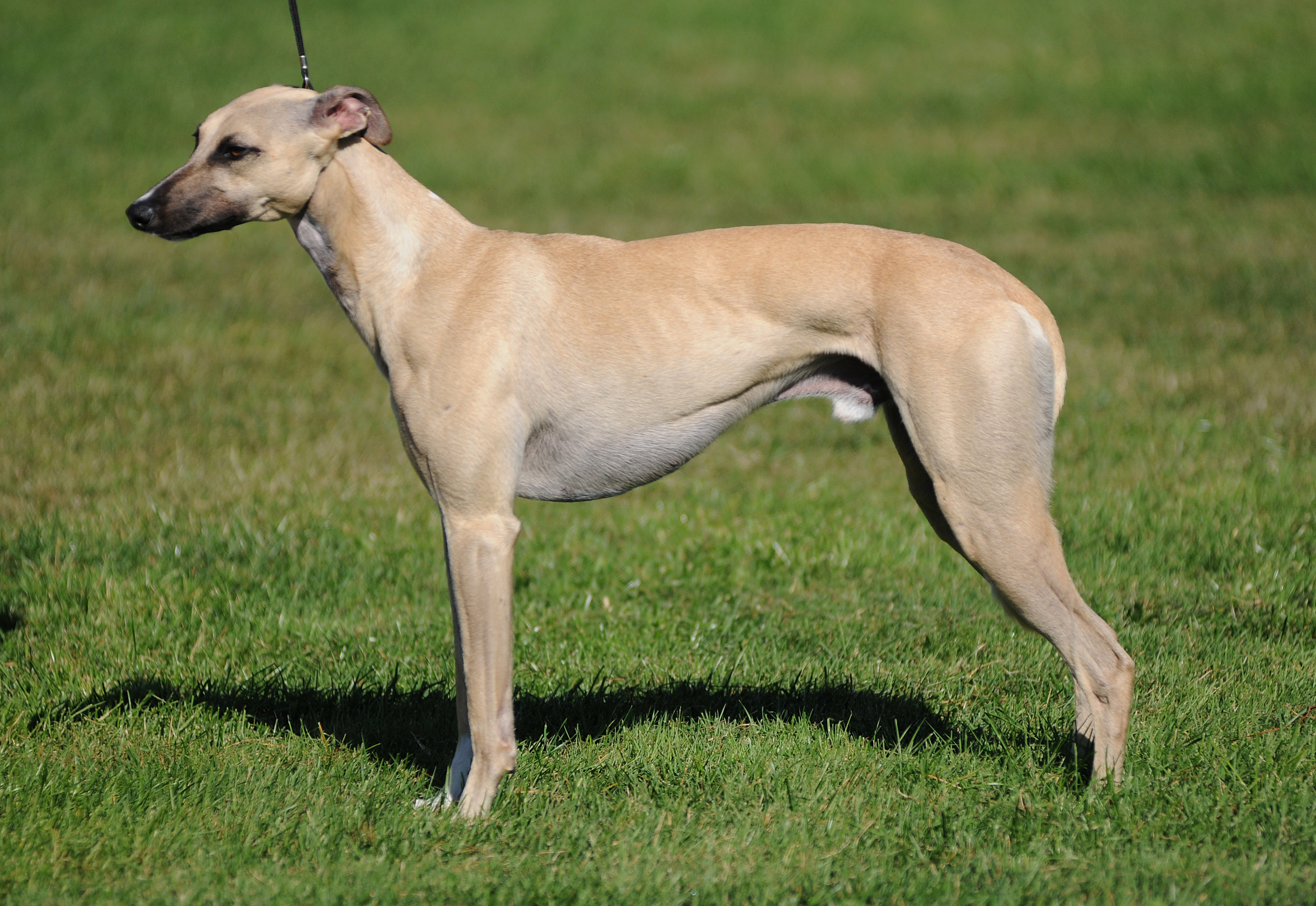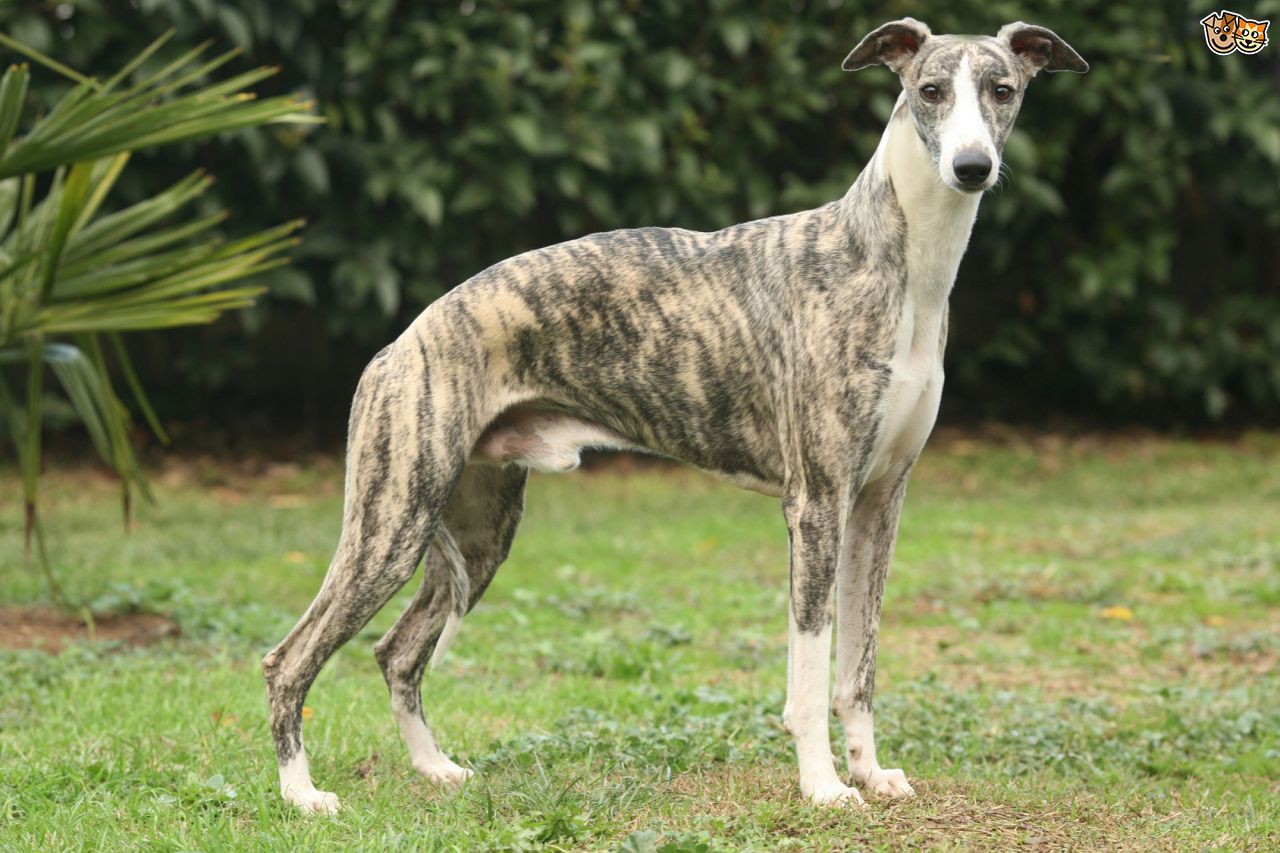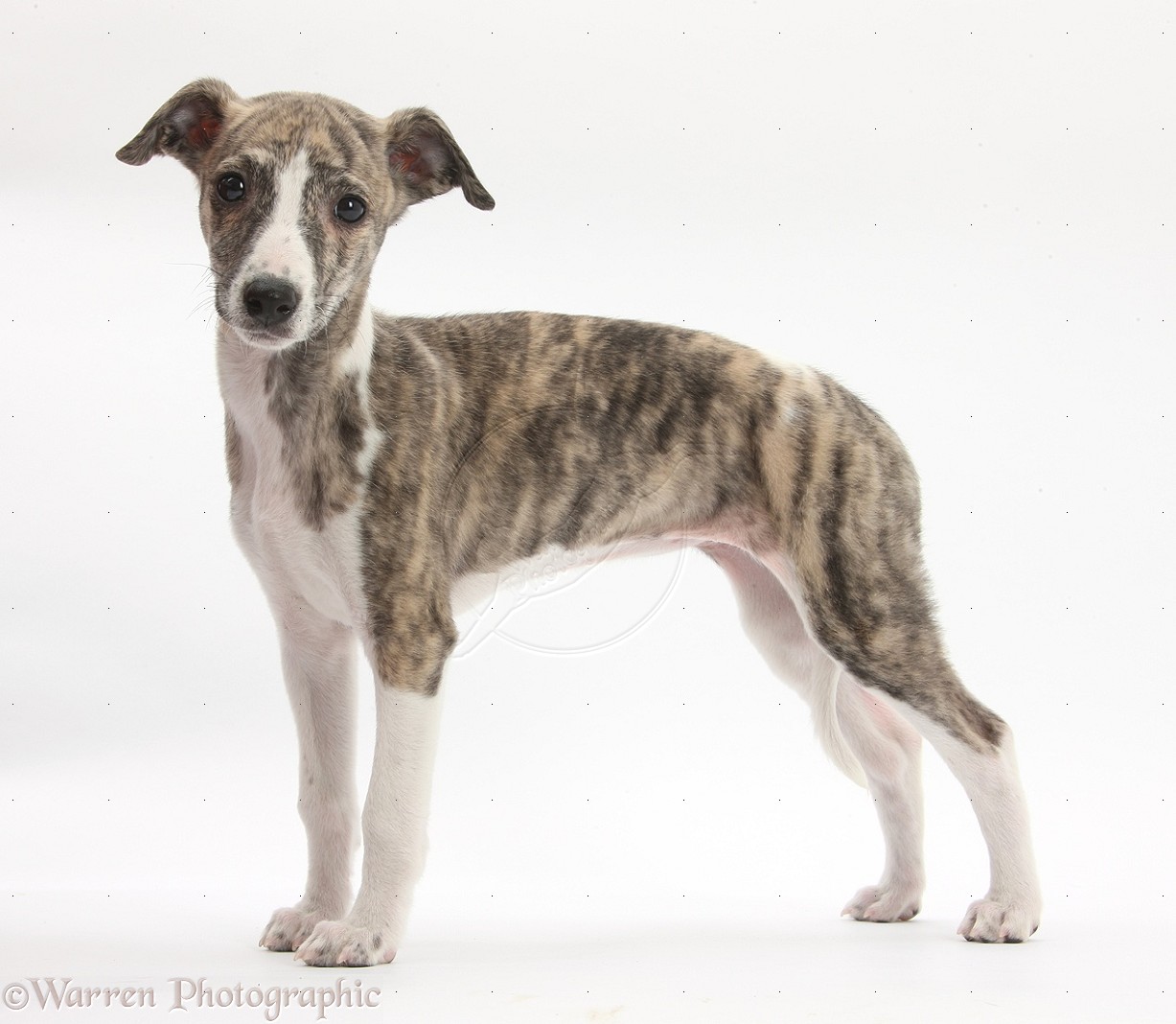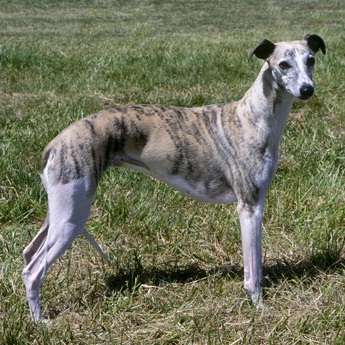
The Breed History
Whippets have been compared to the English Greyhound, in
miniature. They originate from England, and were given official
breed status there in 1891. The breed was derived from crosses of
small English Greyhounds with both rough and smooth-coated
terriers. Later, Italian Greyhound was added to the mix. AKC
recognition occurred in 1888.
Breeding for Function
These medium-sized sight hounds were bred for function so their
conformation development was focused on maximal speed and
agility. Racing, including steeple chasing was a favored sport. Over a
short stretch their speed was so great they could pass a Greyhound.
Their speed is the fastest in this weight range of domesticated
animal (35 mph or 56 km/hr). Rabbit coursing was another sport
that the Whippet was tasked to; informal betting earned them the
historical nickname "poor man's racehorse". Other talents include
ratter, lure coursing, agility, flyball, and obedience. Companion dog
is a common purpose of this breed today.
Physical Characteristics
Height at Withers: female 18-21" (45.5-53.5cm), male 19-22"
(48-56 cm).
Weight: females 14-25 lb (6-11 kg), males 17-28 lb (7.5-12.5 kg).
Coat: The very short coat is firm textured but not coarse, lays
flat and hairs are straight. Any colors are accepted. A longhaired
whippet association exists, though the breed standard for AKC
or any other major registry does not mention these. They cannot
compete as whippets in racing and coursing etc. In the longhaired
standard, miniatures are described and for these dogs; the upper
size limit is 10 lb (4.5 kg).
Longevity: 12-14 years
Points of Conformation: They have a long narrow skull and
tapered muzzle, though the skull is wider between the eyes. The
stop is minimal. Their gait is graceful and smooth. They possess
light bone and lithe musculature. The nose is black, and eyes
must be same color and large, and dark with pigmented palpebral
margins. Small fine-leathered ears (rose ears) are carried back and
folded. The neck is arched, long and fine, though well muscled. The
back is broad and the loin is long. The topline is arched starting over
the loin. The thorax is deep and ribs are well sprung. They possess a
well tucked up abdomen. The tail is long, thin, tapering and carried
low between the legs. It is gently curved upwards, reaching to the
tarsus. Leg bones are straight, feet have hare-to-cat-like shape and
the pads are hard and thick; toes well arched. Dewclaws may be
removed. Metatarsals are short.
Recognized Behavior Issues and Traits
Reported breed characteristics include: Very active outdoors but
quiet in the household, affectionate, intelligent, not barky, and
generally tolerate visitors well, like to sleep on the couch or bed.
Not biters or snappers, easy to handle though very excited while
running around, gentle, good with children, low grooming needs
but don't tolerate temperature extremes well. Love to chase. They
need to be a house pet; not kenneled. Whippets need close human
contact. Invisible fences are not good since they will lose a fight
with intruding dogs, and may go through the boundary if quarry is
sighted. Should not be allowed off leash in open areas. Puppies may
chew, and early obedience training recommended. They have low
shedding, and low doggy odor. Good for indoor living, but if in an
apartment, should get a daily run.
Normal Physiologic Variations
Sight hounds have lower normal ranges for T4 and T3
concentrations compared to other breeds.
The breed can be prone to having eccentrocytes; RBCs that appear
in a peripheral blood smear to have their hemoglobin shifted to one
side of the cell.
Vertebral Heart Size: In lateral views, the VHS was 11.0 +/- 0.5
vertebrae (mean +/- SD) on right-to-left lateral and 11.3 +/- 0.5
vertebrae on left-to-right lateral radiographs, being larger than the
9.7 +/- 0.5 vertebrae proposed by Buchanan (P < 0.0001). The VHS
was 10.5 +/- 0.6 vertebrae on dorsoventral radiographs and 11.1 +/-
0.6 vertebrae on ventrodorsal radiographs. Both values were larger
than the 10.2 +/- 1.5 vertebrae (dorsoventral) (P < 0.0082) or 10.2
+/- 0.8 vertebrae (ventrodorsal) (P < 0.0001) proposed by Buchanan.
Dogs out of racing pedigree lines had a significantly larger VHS
than those out of show pedigree lines, and trained dogs had a
significantly larger VHS than nontrained dogs.
Electrocardiogram Normal Values: Whippets can have normal
ECG values that fall outside of the normal range for other breeds,
probably relating to their vertebral heart size. These include:
P-amplitude (0.30 to 0.42), R-amplitude (3.02 to 4.32), ST-segment
(0.06 to 0.20) and T-amplitude (0.42 to 0.84).
Echocardiographic Normal Values
Parameter Mean Mean В±2SD Range
Body weight (kg) - 13.2 9.0-17.4 9.3-17.2
Body surface area (m2) - 0.56 0.44-0.68 0.45-0.68
Heart rate (bpm) - 93.9 48.5-139.3 54.0-158.0
M-mode (mm)
IVSd - 9.4/ 7.0-11.8/ 7.1-12.9
LVDd - 37.3/ 29.7-44.8/ 25.7-47.5
LVWd - 8.8/ 6.6-10.9/ 6.4-11.5
IVSs - 12.0/ 9.0-15.1/ 9.0-15.5
LVDs - 26.9 /19.8-34.1/ 17.0-36.1
LVWs - 12.4/ 9.3-15.4/ 8.6-17.2
EPSS - 4.2/ 1.4-7.1/ 0.4-9.2
2D
Ao(sa) (mm) - 19.0/ 15.7-22.3 /14.8-24.0
LA(sa) (mm) - 26.5 /20.2-32.8/ 18.4-33.7
LA/Ao - 1.4/ 1.1-1.7/ 1.1-1.7
LA(la) (mm) - 32.0 /26.5-37.6 /23.5-38.7
M-mode measurements: IVSd, interventricular septal thickness in
diastole; LVDd, left ventricular internal diameter in diastole; LVWd,
left ventricular wall thickness in diastole; IVSs, interventricular
septal thickness in systole; LVDs, left ventricular internal diameter
in systole; LVWs, left ventricular wall thickness in systole; EPSS,
E-point to septal separation. 2D measurements: Ao(sa), aortic root
diameter from short-axis view; LA(sa), left atrial diameter from
short-axis view; LA(la), left atrial diameter from long-axis view.
Drug Sensitivities
Anesthesia: Sight hounds require particular attention during
anesthesia. Their lean body conformation with high surface-area-
to-volume ratio predisposes them to hypothermia during
anesthesia. Impaired biotransformation of drugs by the liver
results in prolonged recovery from barbiturate and thiobarbiturate
intravenous anesthetics. Propofol, and ketamine/diazepam
combination are recommended induction agents.
Drug Sensitivity: Longhaired Whippets can be homozygous for the
autosomal recessive MDR1 mutation allowing toxicity due to high
CNS drug levels of ivermectin, doramectin, loperamide, vincristine,
moxidectin, and other drugs. Testing in the US shows 58% carriers
and in Germany shows 60% carrier and 15% affected. A genetic
test is available.
Inherited Diseases
Hip Dysplasia: Polygenically inherited trait causing degenerative
joint disease and hip arthritis. OFA reports 1.4% affected.
Patella Luxation: Polygenically inherited trait causing stifle
instability and arthritis. Too few Whippets have been screened by
OFA to determine an accurate frequency.
Elbow Dysplasia: Polygenically inherited trait causing elbow
arthritis. Too few Whippets have been screened by OFA to determine
an accurate frequency.
Gross Muscle Hypertrophy (Bully Whippets): An incomplete
dominant mutation in the myostatin gene produces gross muscle
atrophy in the homozygous state, and increased muscle mass and
athletic performance in the heterozygous state. Affected dogs
can show intermittent cramping and stiffness. A genetic test is
available.
Disease Predispositions
Cryptorchidism (Retained Testicles): Can be bilateral or unilateral.
Reported at a frequency of 19% in the Whippet Health Survey.
Canine Pattern Baldness: Progressive alopecia developing at
the post- and/or pre-auricular regions, along the ventral neck,
thorax and abdomen, and on the caudomedial thighs. The hair
loss starts around 6 months of age and gradually progresses over
the following year, but remains restricted to the described areas.
Reported at a frequency of 12% in the Whippet Health Survey,
primarily affecting females.
Demodicosis: Overgrowth of demodex mites causing hairloss and
dermatitis. The condition has an underlying immunodeficiency in its
pathogenesis. Reported at a frequency of 8% in the Whippet Health
Survey. Unknown mode of inheritance.
Vitreous Degeneration: A liquefaction of the vitreous gel which
may predispose to retinal detachment resulting in blindness.
Identified in 5.19% of Whippets CERF examined by veterinary
ophthalmologists between 2000-2005.
Allergic Dermatitis: Inhalant or food allergy. Presents with pruritis
and pyotraumatic dermatitis (hot spots). Reported at a frequency of
3% in the Whippet Health Survey.
Hypothyroidism: Inherited autoimmune thyroiditis. 2.9% positive
for thyroid auto-antibodies based on testing at Michigan State
University. (Ave. for all breeds is 7.5%).
Deafness: Congenital sensorineural deafness can be unilateral of
bilateral. Diagnosed by BAER testing. Not associated with a specific
color variety in this breed. Strain reports 2.4% bilaterally deaf
Whippets through BAER testing. Reported at a frequency of 1% in
the Whippet Health Survey. Undetermined mode of inheritance.
Cataracts: Anterior cortex and nuclear punctate cataracts
predominate in the breed. Identified in 2.35% of Whippets CERF
examined by veterinary ophthalmologists between 2000-2005. CERF
does not recommend breeding any Whippet with a cataract.
Persistent Pupillary Membranes: Strands of fetal remnant
connecting; iris to iris, cornea, lens, or involving sheets of tissue. The
later three forms can impair vision, and dogs affected with these
forms should not be bred. Identified in 1.21% of Whippets CERF
examined by veterinary ophthalmologists between 2000-2005.
Primary Lens Luxation: Occurs at an increased frequency in the
breed. Often progresses to secondary glaucoma and blindness.
Reported relative risk of 4.57x versus other breeds.
Color Dilution Alopecia: Associated with the blue (dilute) coat
color in Whippets. Tardive alopecia occurs in areas covered by
darkly pigmented diluted hairs, while the non-pigmented or lightly
pigmented hairs remain unaffected.
Hemangiosarcoma and Hemangioma: In one study, Whippets
had an increased frequency of visceral and nonvisceral
hemangiosarcoma and hemangiomas.
Brachygnathism, Corneal Dystrophy, Ectodermal Defect, Gastric
Dilatation-Volvulus, Micropapilla, Osteochondritis Dessicans-
Shoulder, Prognathism, Progressive Retinal Atrophy, and von
Willebrand's Disease are reported.
Isolated Case Studies
Phosphofructokinase Deficiency: Two male Whippet littermates
presented at 1 year of age with pallor, tachycardia, systolic heart
murmur, dark yellow to orange feces, intermittent lethargy,
pigmenturia, and muscle shivering or cramping after exercise. They
were anemic, with increased serum creatine kinase activity and
hyperkalemia. They were homozygous for the mutation in the PFK
gene found in English Springer Spaniel dogs with PFK deficiency.
Lung Lobe Torsion: A four-year-old, entire male whippet was
presented with a three-day history of lethargy, inappetence,
occasional retching, a soft cough and intermittent episodes of
haemoptysis. Thoracic radiographs suggested a diagnosis of lung
lobe torsion. A concurrent lung lobe torsion of the right cranial and
right middle lung lobes was confirmed at exploratory thoracotomy.
Management included resection of both of the affected lung lobes.
Membranoproliferative Glomerulonephritis and Nephrotic
Syndrome: A 2-year-old spayed female Whippet with proteinuria
and decreased serum albumin was diagnosed by kidney biopsy to
have membranoproliferative glomerulonephritis.
Malignant Lymphoma: A 4-year-old Whippet was diagnosed with
malignant lymphoma with cardiac and bone involvement, using
radiography, histology, nuclear scintigraphy of the skeleton and
heart, and cardiac ultrasonography.
Genetic Tests
Tests of Genotype: Direct test for MDR1 (ivermectin sensitivity)
is available from Washington State Univ. vetmed.wsu.
edu/depts-VCPL/test.asp (Longhaired Whippets).
Direct test for CEA/CH (Collie Eye Anomoly/Choroidal Hypoplasia) is
available from Optigen (Longhaired Whippets).
Direct test for coat length gene is available from VetGen.
Direct test for Bully Whippet gene is available from DDC Veterinary.
Tests of Phenotype: CHIC Certification: Required testing
includes CERF eye examination, ECHOcardiogram by a cardiologist,
BAER testing for deafness, and entry into the Whippet Health
Foundation database. Optional testing includes hip radiographs and
thyroid profile including autoantibodies. (See CHIC website;
caninehealthinfo.org).
Recommend elbow radiographs and patella evaluation.
Miscellaneous
- Breed name synonyms: Snap-dog (historical).
- Registries: AKC, UKC, CKC, KCGB (Kennel Club of Great Britain),
ANKC (Australian National Kennel Club), NKC (National Kennel
Club).
- AKC rank (year 2008): 63 (1,435 dogs registered)
- Internet resources: American Whippet Club:
americanwhippetclub.net
National Whippet Club of Canada: whippetcanada.com
The Whippet Club (UK): thewhippetclub.com
Longhaired Whippet Association:
home.ica.net/~westwood/
Whippet Health Foundation: whippethealth.org
Photo Gallery of Breed - Whippet - Dog Breed








 Animalia Life
Animalia Life